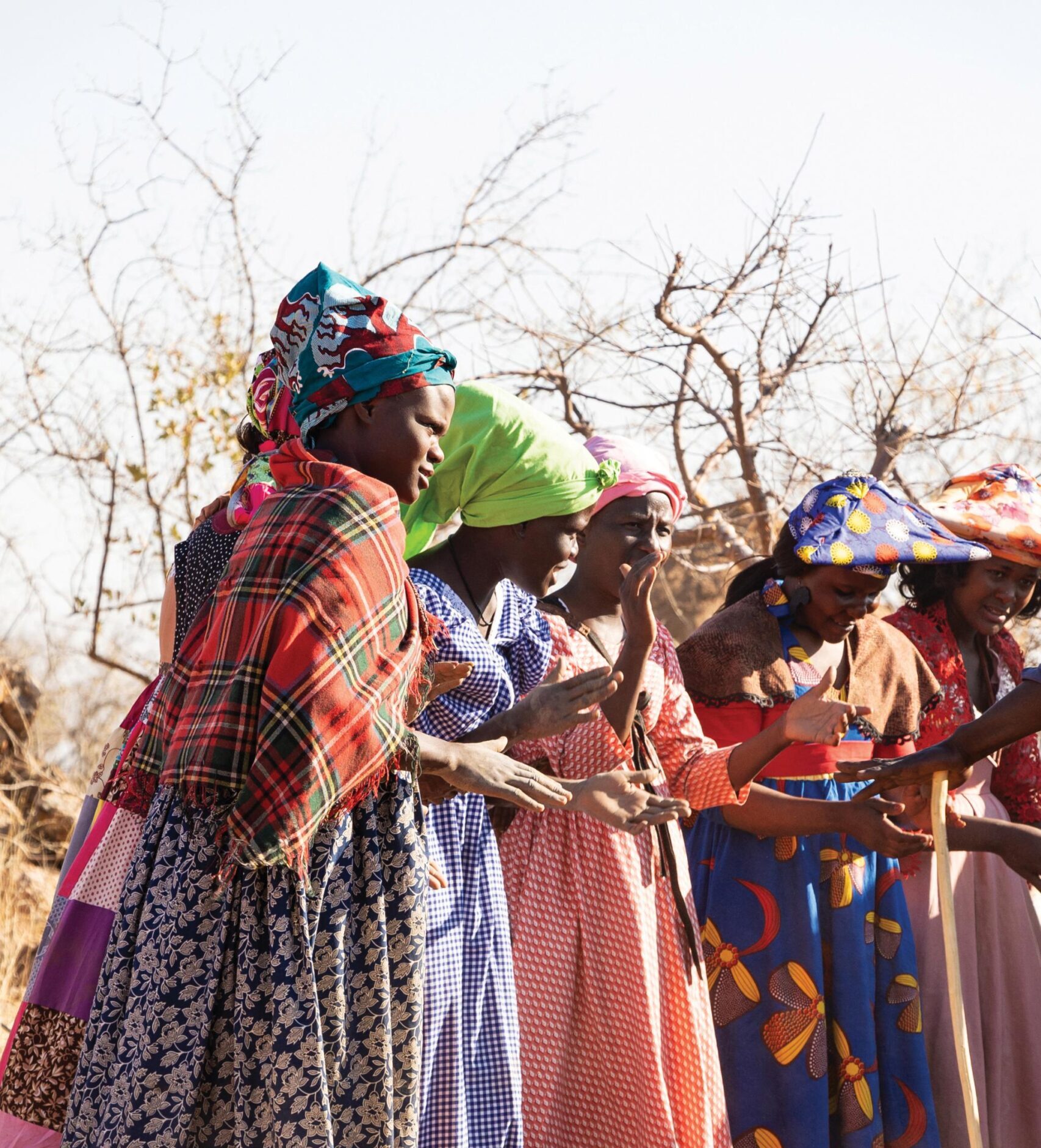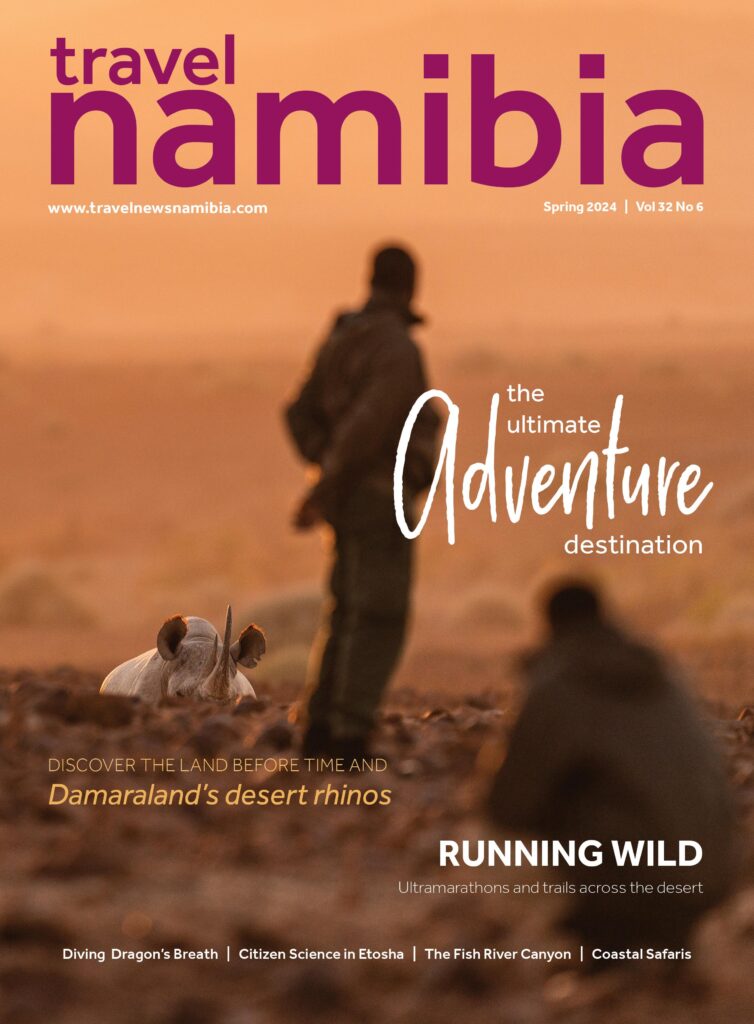

The future of eco-entrepreneurship is
FEMALE
Those who often venture across Namibia’s varied landscapes will agree that roadside stalls selling curios are predominantly run by women. From a distance you can see the colourful dresses of Herero women as they wave at passers-by. Himba women in their striking traditional attire employ the same income-generating strategy of selling crafts, and so do the Damara and Nama ladies with their bright smiles. Namibian women are the backbone of our artisanal crafts industry, and yet when it comes to locally run accommodation ventures, only seldom do you see a woman in the lead role.
Text Charene Labuschagne | Photographs Charene Labuschagne
From the Spring 2024 issue
T hrough its Biodiversity Economy Project, the Deutsche Gesellschaft für Internationale Zusammenarbeit (GIZ) set out to change this norm in Damaraland.
On a media field trip with a handful of the country’s journalists, in the midst of winter, the sky is a hazy, pastel blue. Knowing for certain the country’s largest mountain and highest peak should be visible by now, I peer out the window. Gradually, amidst the change of colours at sunrise, the silhouette of Brandberg begins to reveal itself. You would imagine a dot in the distance growing larger, but the outline of this mass, distinguished only by a slight change of colour, dominates the horizon and everything around it. “Where?” asks PJ, one of my companions, when I excitedly screech, “There it is!” I point to the intimidating landmark, and PJ squints with great effort, gazing to the foreground while falling silent. For a good hour of approaching, it was invisible, and now you cannot ignore the Brandberg’s presence, albeit subtle for the time being.
“By finding these women where they are, as well as facilitating and building capacity where there is already aspiration, Elephant Rock Campsite, Môrewag and Otjokavare is where GIZ hit bingo.”
ELEPHANT ROCK CAMPSITE
Just a few kilometres from the mining town of Uis lies Elephant Rock Campsite, where we are welcomed by Monica Areses, dressed to the nines in a traditional Damara outfit. As we embrace, her fragrant perfume reminds me a little of my beloved grandmother. Her campsite’s reception and dining space looks out onto the western side of Brandberg, making it the favoured place for hikers to overnight before endeavouring to climb to its summit at Königstein.
With a glimmer in her eye, Monica retells the story of how Elephant Rock Campsite was a dream, years in the making. Many moons ago during the tourism season, Monica and her late husband would set out from their home at Henties Bay to sell soft drinks at the White Lady rock painting. A decommissioned oil drum was cut open and a thick blanket, soaked in water, placed inside to keep the drinks cold. Here, her entrepreneurial spirit manifested as ever more visitors encouraged her and her husband to expand their offering, and consider a campsite catered to hikers and adventurers. Monica began discussions with the Tsiseb Conservancy in 2007, seeking to find the perfect spot for a tourism enterprise. After visiting a few sites, they landed at the base of a large granite outcrop in the shadow of Brandberg.
In 2016 the first campsite was ready for visitors. With only a few amenities at the time, Monica worked overtime to ensure her campers had everything they needed, including driving to Uis and back, sometimes multiple times, to collect water. Since then, she has set up neat and sturdy ablutions that run on limited water resources, while the eco-entrepreneur patiently awaits the drilling of a borehole, funded by GIZ.
On a sunset stroll around the granite koppie, Monica guides us to the pièce de résistance of the camp, a magnificently eroded rock in the shape of an elephant. Standing in the cavity that resembles the trunk of an elephant touching the ground, Monica smiles broadly and reminisces over the first time she laid eyes on this formation, knowing instantly that this would become the tourism establishment of her dreams.
In the constant company of the beguiling Brandberg Mountain, which is considered sacred ground in the surrounding communities, Monica built many of the structures at Elephant Rock Campsite with her own hands. “I have helpers, but they need my direction and input, so I laid many of those stones and cement myself,” says Monica, who has a clear vision of what she wants her camp to look like.
Campsite number one, which hosted our group, is situated on a gradual slope of the rocky hill. In its enclave is a spacious boma serving as the common area where campers can come together in the shade and prepare meals, with a crackling fire just beyond its rock wall. A solar geyser provides warm showers, and the grounds have ample space for campers to scatter their tents and enjoy some privacy.
Elephant Rock Campsite’s biggest drawcard is the fact that it is the only campsite west of Brandberg. Now, this might not seem of such significance, until the sun rises and casts a hazy purple hue on the mountain. The monolithic mass creates subtle contrasts in the morning light and paints the backdrop to a cup of coffee with a spark of splendour. Nowhere else is this picture so perfect, with the dawn accompanying our highest mountain in a single frame.
With hesitancy we must peel ourselves away from the hospitality of Monica and her team, and the incredible setting of Elephant Rock Campsite, as more female eco-entrepreneurs await our visit.
MÔREWAG CAMPSITE
About 50 km southwest of Khorixas a duo of donkeys lazing in the shade of a mopane tree welcomes us to Môrewag Campsite. Driving through an impressive arch at the entrance, we are greeted with a warm hug and bright smile by owner and head of operations Dina Namubes.
It is difficult to describe, yet somehow an instant sense of calm descends across the group as we sit down for lunch. Within minutes of being here, I feel right at home, and it is not just the meal of beetroot salad, baked garlic potatoes and peri-spiced chicken that conjures this feeling. There is something in the air here at Môrewag that whispers, “Relax, take it easy.”
From the reception and dining area, it requires a closer peek into the Damaraland sunshine to spot the campsites. Sprawled out over the Môrewag property and brilliantly camouflaged against granite koppies are five glamping sites and a further few regular campsites.
My sojourn for the evening boasts a rustic, outdoor ablution with both the shower and loo coddled by granite boulders. A spacious canvas tent is perched on a concrete platform, and inside, a queen-size bed in crisp, white linen beckons for the evening to come. Below, a built-in fireplace and pergola-covered food prep area sits pretty between more boulders. This is the kind of campsite I would spend a good amount of money on, and yet I am lucky enough to be their guest.
Just a stone’s throw from my abode sits one of Môrewag’s biggest drawcards – an ancient rock painting of a hunter being praised by his tribe for bringing home a kill. Dina saw this as a golden opportunity to set up a little bench and she insists that guests sit here with a glass of wine, marvel at the rock painting and ponder over the view of the cascading flat-top mountains in the distance. A short, guided walk or drive from the campsite leads to another rock painting, where a unique depiction of a two-metre-long snake sits on a slanted boulder face. There are undoubtedly many more of these ancient paintings to be discovered in the area, and the staff at Môrewag are eager to seek them out on nature walks with guests.
With the help of the GIZ Biodiversity Economy Project, Môrewag has an impressive infrastructure, including water tanks and solar power. Nearby sits a solar-powered borehole, which offers essential irrigation for the community garden that supplies Dina’s kitchen at Môrewag. It is clear that every step taken to develop this tourism establishment is done consciously and with the end goal of being a beacon of sustainability.
Around the campfire at dinner, the cool winter air is filled with chatter about the promising future of Môrewag Campsite. Dina raises a toast to the official opening of her dream establishment, acknowledging and visibly touched by GIZ’s support to help make it all happen. Once again, the heartfelt hospitality of entrepreneurial women, paired with spectacular settings, leaves me determined to return.
OTJOKAVARE HERERO LIVING MUSEUM
Driving along the western border of Etosha National Park, passing the veterinary control border, an inconspicuous tyre on the roadside indicates our turn-off to the Otjokavare Herero Living Museum. Considering this is my first time visiting a living museum, I am all bright-eyed and bushy-tailed at this new experience.
Welcomed by member and supervisor of Otjokavare, Mr Vetowojao Tjauira, a short stroll around some boulders and through mopane bushveld leads us to front-row seats of a small, staged village. A grey-haired Tate, the headman of this community, is seated in a camping chair at the entrance to greet us while one of his grandsons, undoubtedly his Tate’s shadow, shyly stands by his side.
The buff sand is juxtaposed by vibrant coloured dresses as clusters of Herero women, dressed in their iconic traditional attire, kneel and sit on the ground, performing multiple activities. Here, two ladies stone-grind millet to flour for porridge, while another attentively rocks a suspended calabash back and forth to produce butter. And there, with their cow-horn-inspired headdresses, two more Herero women plaster the floor of a new hut with a mixture of cow dung, grass and water.
Vetowojao guides our group through the various huts and activities, taking extra time at the village’s main structure. This hut’s entrance is in line with the holy fire, where the men of the village sit and tell fables. Inside, the matriarch (Meme) of the village sits grinding leaves and bark into a fragrant powdered perfume, sharing some with me. Dabbing a finger in the powder and rubbing it onto my wrist, the fragrance bursts with earthy, oud and sweet notes. The OvaHerero call it otjizumba, and it smells divine!
While Vetowojao translates, the Meme explains that this hut is the head of the village. All celebrations or ceremonies involve this structure: married couples would spend their wedding night (or week) here, babies are born here and elderly community members spend their final moments here. What a transient space, and what an honour to witness it, along with all the other aspects of Otjokavare.
Naturally, the time comes for a dance number, and the ladies take centre stage again, their layers upon layers of petticoats swaying with gravitas as they sing a sweet melody of call and response. While we may have been welcomed to Otjokavare by men, it is the women here who truly bring vibrance and inspiration to the living museum, another reminder that the GIZ Biodiversity Economy Project in this region seeks to champion female eco-entrepreneurs. By finding these women where they are, as well as facilitating and building capacity where there is already aspiration, Elephant Rock Campsite, Môrewag and Otjokavare is where GIZ hit bingo. TN






